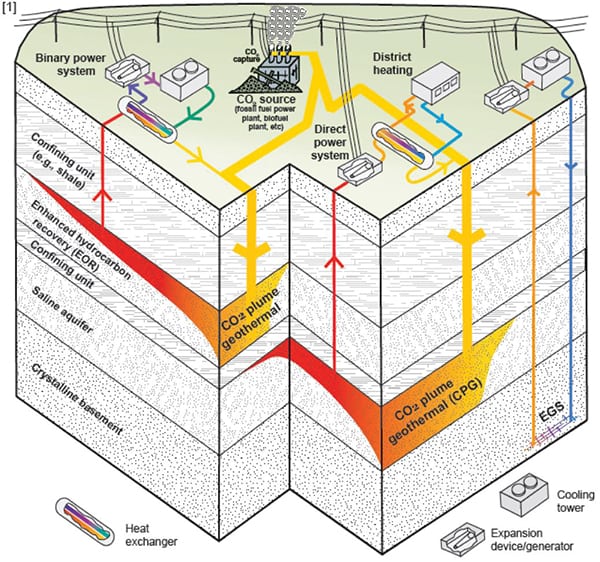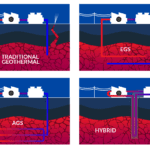A new kind of geothermal power being developed by a team of scientists from the Lawrence Livermore National Laboratory (LLNL), the University of Minnesota, and the Ohio State University could sequester carbon dioxide (CO2) while boosting power generation by at least 10 times compared to existing geothermal energy approaches.
The plant design resembles “a cross between a geothermal plant and the Large Hadron Collider,” featuring a network of subsurface concentric rings of horizontal wells inside which CO2, nitrogen, and water circulate to draw heat from deep below ground up to the surface, where it can be used to turn turbines and generate electricity. “This well arrangement encircles the injected fluids with a subsurface hydraulic dam, functioning much like a hydroelectric dam. The intent is to recover the maximum energy benefit from fluid injection operations, a major improvement over conventional geothermal power systems,” noted Tom Buscheck, an LLNL earth scientist, as the team debuted an expanded version of the design at a December American Geophysical Union meeting.
The researchers say CO2 absorbs subterranean heat more efficiently than water. Extraction rates are 1.7 to 2.7 times larger with CO2 than with water because CO2 mass flow rates are up to five times greater (given a fixed pressure difference between injection and production wells). Computer simulations suggest that a system of four concentric rings of horizontal wells about three miles below the ground, with the outer ring being more than 10 miles in diameter, has the capacity to produce as much as 500 MW—much more than the average 38 MW produced by a conventional geothermal plant. A plant of that design might also sequester as much as 15 million tons of CO2 per year.
The approach, which stems from a design developed by Martin Saar of the University of Minnesota, adds nitrogen to the mix to enable highly efficient energy storage for an unprecedented duration. “Much of the energy required to drive the hot fluids out of the deep subsurface to surface power plants can be shifted in time to coincide with minimum power demand or when there is a surplus of renewable power on the electricity grid,” Buscheck explained.
Meanwhile, the fledgling technology has a number of advantages over enhanced geothermal systems (EGS), which are essentially man-made reservoirs created where there is hot rock but little natural permeability of fluid saturation. In EGS, fluid is injected into the subsurface under controlled conditions, which causes pre-existing fractures to open. The new plant design doesn’t require hydrofracturing of the reservoir, and it uses lower reservoir temperatures and pressures. Plus, it would likely sequester more CO2 with more emphasis on sequestration, the researchers say.
There are a number of caveats, however. One is that it would need to be connected, likely by pipeline, to a large CO2 source, possibly a coal-fired plant fitted with carbon capture. Buscheck added, however, that a pilot plant based on this design could initially be powered solely by nitrogen injection, in order to prove the economic viability of using CO2. The study also showed that this design can work effectively with or without CO2, broadening where this approach could be deployed. The research team is currently working on more detailed computer model simulations and economic analyses for specific geologic settings in the U.S.
Startup company Heat Mining Co., which was spun off from the University of Minnesota, holds the worldwide patent to an earlier form of the researchers’ approach, dubbed “CO2 Plume Geothermal” (CPG) and is looking to put an operational project online by 2016. The South Dakota–based company admits, however, that its CPG power system, which works “like a giant pressure cooker” to vent pressure and reduce the risk of CO2 leaks, requires a capped saline aquifer at least 2.5 kilometers deep, a minimum aquifer temperature of 50C, and a minimum of 1 million metric tons of stored CO2 (Figure 6).
—Sonal Patel, associate editor (@POWERmagazine, @sonalcpatel)











